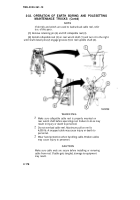TM-9-2320-361-10 - Page 249 of 392
TM 9-2320-361-10
2-38. OPERATION IN DUSTY OR SANDY AREAS (Contd)
CAUTION
Do not attempt to jump vehicle out of deep sand with quick
transmission gear changes. Doing this may result in damage
to equipment.
(4)
If vehicle becomes stuck in deep sand, use second vehicle with winch for
recovery operation. Refer to para. 2-24.
d. Stopping or Parking.
(1)
Park vehicle in a sheltered area out of blowing dust or sand whenever
possible. If sheltered area is not available, park so vehicle does not face into wind.
(2)
If sheltered area is not available, cover vehicle with paulins. When entire
vehicle cannot be covered, protect windows, cab, and engine compartment with
paulins to prevent entry of sand or dust.
(3)
Stop vehicle and engine. Refer to para. 2-17.
e. After Operation.
WARNING
Compressed air used for clening purposes will not exceed
30 psi. Use only with effective chip guarding and personal
protective equipment (goggles/shield, gloves, etc.).
(1)
At end of daily operation, use low air pressure to remove all sand from
vehicle engine compartment, areas around brakes, drums, and spring seats.
CAUTION
Do not allow dust or sand to enter fuel tank when filling.
Doing this may result in damage to fuel system.
(2)
Fill fuel tank. Tighten filler cap securely after filling.
(3)
Perform after operation PMCS. Refer to table 2-2.
(4)
Reinflate tires to proper operating pressure if deflated. Refer to
para. 3-14f.
2-39. OPERATION IN RAINY OR HUMID CONDITIONS
a. General.
Material inactive for long periods in hot, humid weather can rust
rapidly. Fungus growth may develop in the fuel tank as well as on canvas paulin,
seats, and other components. Frequent inspection, cleaning (refer to para. 2-9),
and lubrication are necessary to maintain the readiness of vehicles in rainy or
humid conditions. Fuel filters and air reservoirs must be drained frequently
because of high condensation in fuel and air systems.
2-188
Back to Top




















